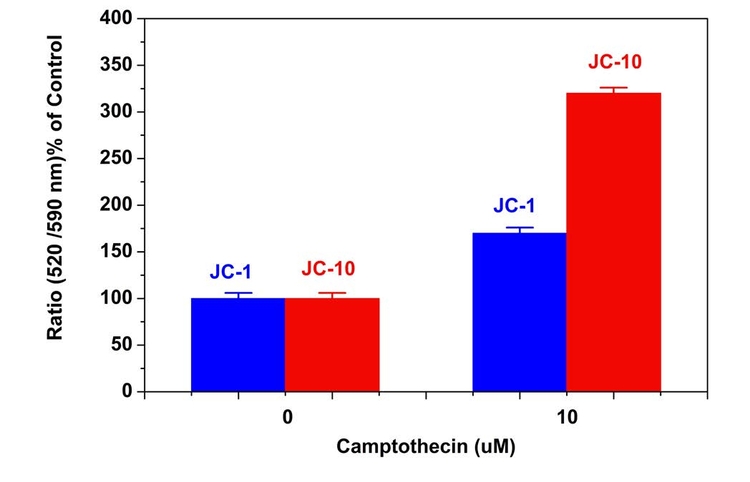Mitochondrial Membrane Potential
The mitochondrial membrane potential (ΔΨm), generated by the electron transport chain, is a key parameter necessary for healthy mitochondrial functioning. Together with the proton gradient, it generates the driving force behind mitochondrial ATP synthesis. It plays a key role in mitochondrial homeostasis through selective elimination of dysfunctional mitochondria, and is an essential component of mitochondrial calcium homeostasis.
A distinctive feature of the early stages of apoptosis is the disruption of normal mitochondrial function. A collapse in mitochondrial membrane and redox potential may induce unwanted loss of cell viability and be a cause of various pathologies. We offer a wide assortment of fluorescent probes for analyzing aspects of normal mitochondrial activity in live cells, including reactive oxygen species (ROS) production, mitochondrial membrane potential and calcium flux.
A distinctive feature of the early stages of apoptosis is the disruption of normal mitochondrial function. A collapse in mitochondrial membrane and redox potential may induce unwanted loss of cell viability and be a cause of various pathologies. We offer a wide assortment of fluorescent probes for analyzing aspects of normal mitochondrial activity in live cells, including reactive oxygen species (ROS) production, mitochondrial membrane potential and calcium flux.
JC-10™ Dual-Emission ΔΨm Probe

Camptothecin induced mitochondrial membrane potential changes were measured with JC-10™ (Cat No. 22204) and JC-1 (Cat No. 22200) in Jurkat cells. After Jurkat cells were treated with camptothecin (10 µM) for 4 hours, JC-1 and JC-10™ dye loading solutions were added to the wells and incubated for 30 minutes. The fluorescent intensities for both J-aggregates and monomeric forms of JC-1 and JC-10™ were measured at Ex/Em = 490/525 nm and 540/590 nm with NOVOstar microplate reader (BMG Labtech).
Features of JC-10™:
- Easy-to-Use: JC-10™ does not percipitate when diluted into aqueous buffers, eliminating artifacts.
- Robust: JC-10™ has smaller assay deviations due to its enhanced solubility in aqueous media and higher sensitivity.
- Enhanced Signal: JC-10™ has a higher signal-to-background ratio than JC-1.
- Enhanced Sensitivity: JC-10™ has the ability to detect subtle changes in ΔΨm loss better than JC-1 in all tested cell lines.
- Broad Applications: JC-10™ can be used for primary rat hepatocytes.
- Convenient: JC-10™ is compatible with fluorescence microplate readers, cell imagers and flow cytometers.
Table 1. JC-10™ and JC-1 dual-emission mitochondrial membrane potential probes.
| Probe ▲ ▼ | Ex/Em ▲ ▼ | Ex/Em ▲ ▼ | Filter Set ▲ ▼ | Unit Size ▲ ▼ | Cat No. ▲ ▼ |
| JC-10™ *Superior alternative to JC-1* | 508/524 (monomer) | 508/570 (aggregate) | FITC (monomer) TRITC (aggregate) | 5x100 µL | 22204 |
| JC-1 | 515/530 (monomer) | 515/590 (aggregate) | FITC (monomer) TRITC (aggregate) | 5 mg | 22200 |
| JC-1 | 515/530 (monomer) | 515/590 (aggregate) | FITC (monomer) TRITC (aggregate) | 50 mg | 22201 |
Table 2. Cell Meter™ JC-10™ assay kits for measuring mitochondrial membrane potential.
| Probe ▲ ▼ | Instrument ▲ ▼ | Ex (nm) ▲ ▼ | Em (nm) ▲ ▼ | Cutoff/Channel ▲ ▼ | Unit Size ▲ ▼ | Cat No. ▲ ▼ |
| Cell Meter™ JC-10 Mitochondrion Membrane Potential Assay Kit *Optimized for Microplate Assays* | Microplate Reader | 490/540 nm | 525/590 nm | 515/570 nm | 500 tests | 22800 |
| Cell Meter™ JC-10 Mitochondrion Membrane Potential Assay Kit *Optimized for Flow Cytometry Assays* | Flow Cytometer | 488 nm laser | 530/30 575/26 | FITC Channel PE Channel | 100 tests | 22801 |
Mitochondrial-Selective Rhodamine Esters
Cell-permeable cationic rhodamines, such TMRE and TMRM, are readily sequestered by active mitochondria, and commonly used to label mitochondria in living cells. Like JC-10™, TMRE and TMRM uptake in mitochondria is driven by the mitochondrial membrane potential. Both dyes have been successfully for dymanic and in situ quantitative measurements, to screen for inhibitors of the mitochondrial transition pore, to assess the functionality of mitochondria in living cells, and can be used to discrimate between viable and non-viable cell populations. These potentiometric dyes exhibit minimal self-quenching, low cytotoxicity and have reasonable photostability, and their fluorescence intensities can be measured with either a flow cytometer or fluorescence microscope. In comparison to TMRM, TMRE is slightly more hydrophobic.
Product ordering information
Table 4. Potentiometric dyes and kits for measuring mitochondrial membrane potential.
| Probe ▲ ▼ | Unit Size ▲ ▼ | Cat No. ▲ ▼ |
| JC-10 *Superior alternative to JC-1* | 5x100 µL | 22204 |
| JC-1 [5,5,6,6-Tetrachloro-1,1,3,3-tetraethylbenzimidazolylcarbocyanine iodide] *CAS#: 3520-43-2* | 5 mg | 22200 |
| JC-1 [5,5,6,6-Tetrachloro-1,1,3,3-tetraethylbenzimidazolylcarbocyanine iodide] *CAS#: 3520-43-2* | 50 mg | 22201 |
| Cell Meter™ JC-10 Mitochondrion Membrane Potential Assay Kit *Optimized for Microplate Assays* | 500 tests | 22800 |
| Cell Meter™ JC-10 Mitochondrion Membrane Potential Assay Kit *Optimized for Flow Cytometry Assays* | 100 tests | 22801 |
| TMRE [Tetramethylrhodamine ethyl ester] *CAS#: 115532-52-0* | 25 mg | 22220 |
| TMRM [Tetramethylrhodamine methyl ester] *CAS#: 115532-50-8* | 25 mg | 22221 |
| Cell Meter™ Mitochondrion Membrane Potential Assay Kit *Orange Fluorescence Optimized for Microplate Reader* | 500 Tests | 22805 |
| Cell Meter™ Mitochondrion Membrane Potential Assay Kit *Red Fluorescence Optimized for Microplate Reader* | 500 Tests | 22807 |
| Cell Meter™ NIR Mitochondrion Membrane Potential Assay Kit *Optimized for Flow Cytometry* | 100 Tests | 22802 |